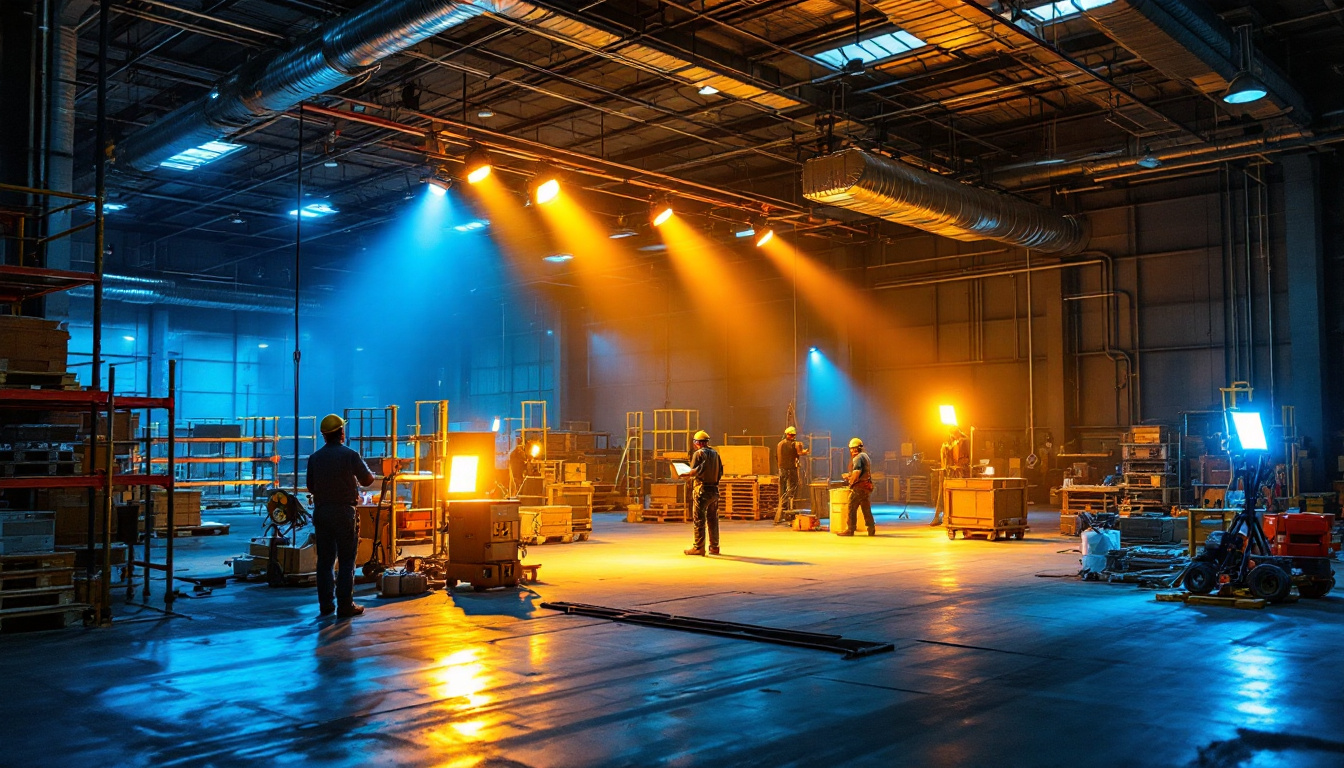
The evolution of warehouse lighting has undergone significant transformation over the years, with LED technology leading the charge. Lighting contractors are increasingly recognizing the advantages of LED lights, not just for their energy efficiency but also for their versatility and longevity. This article explores the best LED lights for warehouses, highlighting how they can revolutionize the way lighting contractors approach their projects.
Effective lighting is crucial in a warehouse setting, impacting everything from employee safety to operational efficiency. Poor lighting can lead to accidents, decreased productivity, and even damage to goods. Therefore, selecting the right lighting solution is essential for any warehouse operation.
LED lights provide a bright, clear illumination that enhances visibility throughout the space. This is particularly important in large warehouses where shadows and dark corners can pose risks. By investing in quality LED lighting, contractors can ensure that warehouses are well-lit and safe for all workers.
LED lighting offers numerous advantages over traditional lighting options, making it a preferred choice for warehouses. Understanding these benefits can help lighting contractors make informed decisions when selecting products for their clients.
One of the most significant benefits of LED lights is their energy efficiency. LEDs consume considerably less power than incandescent or fluorescent lights, resulting in lower electricity bills. This is particularly important for warehouses, which often operate for extended hours and require consistent lighting.
By switching to LED lighting, warehouses can reduce their energy consumption by up to 75%. This not only translates to cost savings but also contributes to a more sustainable operation, aligning with the growing emphasis on environmental responsibility in the business world.
LED lights are known for their impressive lifespan, often lasting up to 25,000 hours or more. This longevity means that warehouses can reduce maintenance costs associated with frequent bulb replacements. For lighting contractors, this translates into fewer service calls and a more satisfied clientele.
Additionally, LEDs are more durable than traditional lighting options. They are resistant to shock, vibration, and temperature fluctuations, making them ideal for the often harsh conditions found in warehouses. This resilience ensures that the lighting remains functional and effective over time.
Another key advantage of LED lighting is the quality of light it provides. LEDs emit a bright, consistent light that enhances visibility and reduces eye strain for workers. This is particularly beneficial in environments where precision is crucial, such as in sorting and assembly areas.
Furthermore, LEDs are available in various color temperatures, allowing contractors to choose the right hue for specific tasks. Whether it’s a cooler light for a more alert atmosphere or a warmer tone for a relaxed environment, the versatility of LED lighting can be tailored to meet the unique needs of each warehouse.
When it comes to selecting LED lights for warehouses, there are several types to consider. Each type has its own advantages and is suited for different applications within the warehouse environment.
High bay LED lights are designed for large spaces with high ceilings, such as warehouses and distribution centers. These lights provide powerful illumination and are typically mounted at heights ranging from 15 to 40 feet. They are ideal for areas where visibility is crucial, such as loading docks and storage areas.
High bay lights are available in various wattages and lumen outputs, allowing contractors to choose the right specifications based on the warehouse’s layout and lighting requirements. Their energy efficiency and long lifespan make them a popular choice for warehouse applications.
LED flood lights are another excellent option for warehouses, especially for outdoor areas or large open spaces. These lights are designed to cover a wide area with bright, uniform lighting, making them suitable for loading docks, parking lots, and outdoor storage areas.
With their robust construction and weather-resistant features, LED flood lights can withstand the elements, ensuring reliable performance regardless of the conditions. This durability is particularly important for warehouses that operate in varying climates.
LED strip lights offer a flexible lighting solution for warehouses, allowing contractors to illuminate specific areas or features. These lights can be installed in tight spaces, along shelves, or under cabinets, providing targeted illumination where it is needed most.
Moreover, LED strip lights are available in various colors and brightness levels, enabling customization to enhance the warehouse’s overall aesthetic. They can also be used in conjunction with other lighting types to create a layered lighting approach that improves visibility and functionality.
Choosing the right LED lights for a warehouse involves several considerations. Lighting contractors must evaluate various factors to ensure that they select the best products for their clients’ needs.
The layout and design of the warehouse play a significant role in determining the type and placement of LED lights. Factors such as ceiling height, shelf placement, and the overall flow of the space must be taken into account to ensure optimal lighting coverage.
Lighting contractors should conduct a thorough assessment of the warehouse layout, identifying areas that require more illumination and those that may benefit from targeted lighting solutions. This strategic approach can enhance safety and efficiency throughout the facility.
When selecting LED lights, it is essential to consider their energy efficiency ratings. Look for products that are ENERGY STAR certified or have other recognized efficiency ratings. These certifications indicate that the lights meet specific performance standards, ensuring that they provide the maximum energy savings.
Additionally, understanding the wattage and lumen output of the lights can help contractors determine the best options for their projects. Balancing energy consumption with adequate brightness is key to achieving an effective lighting solution.
Installation and maintenance requirements should also be considered when selecting LED lights for warehouses. Some lights may require specialized installation techniques or equipment, which can affect project timelines and costs. Contractors should assess the ease of installation for each product and factor this into their decision-making process.
Furthermore, understanding the maintenance needs of the selected lights is crucial. While LEDs generally require less maintenance than traditional lighting options, some models may still require periodic cleaning or inspections to ensure optimal performance. Choosing products with minimal maintenance requirements can enhance the overall efficiency of the lighting system.
Examining real-world examples of successful LED lighting implementations can provide valuable insights for lighting contractors. These case studies highlight the transformative impact of LED lights in warehouse settings.
A leading distribution center recently transitioned from traditional fluorescent lighting to high bay LED lights. The project involved retrofitting the entire facility, which spans over 500,000 square feet. The results were remarkable.
After the installation, the distribution center reported a 60% reduction in energy costs. Workers also noted improved visibility, leading to increased productivity and a decrease in accidents. The longevity of the LED lights further contributed to reduced maintenance costs, making the transition a win-win for the facility.
An automotive parts warehouse faced challenges with inadequate lighting, leading to inefficiencies in order picking and sorting. The warehouse management decided to invest in LED flood lights for both indoor and outdoor areas.
Post-installation, the warehouse experienced a significant boost in operational efficiency. The brighter, more uniform lighting allowed workers to navigate the space more easily, reducing errors and speeding up order fulfillment. The improved lighting also enhanced safety, particularly in outdoor loading areas.
The future of LED lighting in warehouses looks promising, with ongoing advancements in technology and design. As lighting contractors continue to embrace LED solutions, several trends are emerging that will shape the industry.
Smart lighting technology is becoming increasingly prevalent in warehouse environments. These systems allow for automated control of lighting based on occupancy, time of day, or specific tasks. By integrating smart technology, warehouses can optimize energy usage and enhance efficiency.
For lighting contractors, this presents an opportunity to offer clients cutting-edge solutions that not only improve lighting quality but also contribute to significant energy savings. As smart lighting becomes more accessible, it is likely to become a standard feature in modern warehouses.
As sustainability becomes a priority for many businesses, the integration of LED lighting with renewable energy sources is gaining traction. Solar-powered LED lights, for example, can provide an eco-friendly lighting solution for outdoor areas of warehouses.
Lighting contractors can play a pivotal role in helping clients transition to renewable energy solutions, ensuring that warehouses are not only well-lit but also environmentally responsible. This shift aligns with broader trends toward sustainability in the industry.
LED lighting has transformed the way lighting contractors approach warehouse projects. With their energy efficiency, longevity, and superior light quality, LED lights offer a multitude of benefits that enhance safety and productivity in warehouse environments.
By understanding the various types of LED lights available, considering key selection criteria, and learning from successful case studies, lighting contractors can make informed decisions that lead to successful implementations. As the industry continues to evolve, embracing smart technology and renewable energy solutions will further enhance the role of LED lighting in warehouses, paving the way for a brighter, more efficient future.
Ready to elevate your warehouse lighting projects to new heights? Look no further than LumenWholesale, where we provide lighting contractors with the highest quality LED solutions at unbeatable wholesale prices. Our spec-grade products are designed to meet the most rigorous industry standards, ensuring you deliver reliability and high performance in every installation. Say goodbye to middleman markups and hello to cost-effective, premium lighting with the convenience of free shipping on bulk orders. Don’t compromise on quality or value—choose LumenWholesale for your next project and experience the ultimate in lighting excellence. Wholesale Lighting at the Best Value awaits you. Let’s brighten the future of warehouse lighting together!

Discover how lighting contractors can enhance their services and boost profitability with LED emergency lighting solutions.

Discover innovative cost-saving strategies for lighting contractors focusing on light globe bases.

Discover the essential role of two lamp fluorescent fixtures in modern lighting projects.

Discover innovative strategies to future-proof your street lighting projects.